A Comprehensive Guide to Learning Kite Surfing


Intro
Kite surfing, often viewed as a blend of surfing and paragliding, has attracted many adventurers and thrill-seekers across the globe. This sport demands not only physical prowess but also a deep understanding of wind, water, and environment. As more enthusiasts dive into this captivating world, having a solid foundation in the essential elements of kite surfing becomes crucial. This guide aims to lay out everything a budding kite surfer needs to start their journey, from gear essentials and safety precautions to skill development and community engagement.
A Brief Overview
Before getting into the technical nitty-gritty, it’s vital to understand the unique aspects of kite surfing that set it apart from traditional water sports. The wind is your best friend; it propels the kite, giving you the power to ride. The synergy between the rider, the kite, and the water can create an exhilarating experience that few other sports can match. But as thrilling as it may be, kite surfing also demands respect for nature and for the craft itself.
Why Kite Surfing?
You might wonder what draws people to kite surfing. The sense of freedom it offers is unparalleled. Whether you're carving through the waves or launching high into the air, the adrenaline rush speaks for itself. Moreover, kite surfing fosters a vibrant community of individuals who share a passion for adventure. From local meetups to international competitions, there's no shortage of opportunities to connect and grow with fellow riders.
This guide is structured to cover all that you need to embark on your kite surfing adventure. It will arm you with knowledge about the gear you’ll need, help you refine your skills, and encourage responsible practice in the great outdoors.
So, let’s dive headfirst into the first essential element of kite surfing: gear selection.
Prelude to Kite Surfing
Kite surfing, a blend of elements that pull together wind, water, and the thrill of riding, is more than just a sport; it’s a lifestyle that richens the spirit and connects people with nature. Understanding the fundamentals of kite surfing is crucial for anyone looking to dive into this exhilarating experience. Whether you are a novice setting foot on the water for the first time or a seasoned rider polishing your skills, getting to grips with the core concepts and importance of kite surfing plays a significant role in your journey.
This section lays the groundwork for what’s to follow, serving as the keystone that joins the various aspects of kite surfing, namely equipment, techniques, safety protocols, locations, and communities. Each of these components is interlaced with the recreational and technical prowess required to transform a kite surfer into a proficient rider.
Overview of the Sport
Kite surfing, as an adventurous water sport, combines aspects of surfing and paragliding. Picture this: harnessing a powerful kite with a wide wingspan to catch the wind’s favor, while riding a board along waves with the ocean beneath your feet. As charming as it sounds, kite surfing is not merely about onboarding the sport; it encapsulates a unique culture and community. Riders often gather on picturesque beaches, showcasing their skills while sharing tips and tricks with one another.
The beauty of this sport is that it’s accessible for different skill levels. From gentle breezes giving beginners the freedom to glide without fear to more demanding wind conditions that challenge even the most skilled instructors, there’s a place in kite surfing for everyone. This sport is not only a thrilling outlet for adrenaline, but it also builds a profound appreciation for the natural elements and teaches valuable lessons in teamwork, persistence, and safety.
History and Evolution
Tracing the roots of kite surfing takes us back to the 13th century. Early forms of kite flying were used primarily for military purposes and scientific experiments. As innovative spirits looked to the horizon, they saw potential in these soaring structures. Fast forward to the 1970s, when the idea of harnessing kite power for surfing began to emerge. The initial designs were rudimentary, with only basic control over the kite, leading to a rather tumultuous riding experience.
The real game changers emerged in the 1990s when enthusiasts started developing specialized kites. Companies began producing inflatable kites, which were considerably easier to manage and more reliable than their predecessors. These innovations marked a turning point. Kite surfing began to surge, with more riders flocking to coastal shores, ready to harness the power of the wind.
From its humble beginnings, kite surfing has blossomed into a multi-billion dollar industry, fostering a global community of riders and instructors. Today, advances in technology continue to propel the sport forward, with new gear and techniques emerging all the time. Yet, amidst all this evolution, the heart of kite surfing remains unchanged – it’s about the wind in your hair, the waves beneath your feet, and the camaraderie among those who share in this exhilarating pursuit.
"Kite surfing is not just about the ride; it's an exhilarating dance with nature, a sport that invites you into a lifelong journey of learning and exploration."
Understanding these foundational elements of kite surfing is vital as they set the stage for everything else to follow in this guide.
Understanding Kite Surfing Equipment
Kite surfing is a thrilling sport, but to truly enjoy it, one must comprehend its equipment. Knowing what gear you need is essential, as each component plays a unique role in the experience. Understanding kite surfing equipment not only improves performance but also enhances safety. The right gear makes a big difference in comfort, capability, and control. Without this understanding, a rider may end up with gear that doesn’t suit their needs, which can lead to complications on the water.
Kites: Types and Sizes
Kites are perhaps the heart of the gear puzzle. They come in various shapes and sizes, tailored for different wind conditions and riding styles. Broadly, kites can be classified into two types: inflatable kites and foil kites.
- Inflatable Kites: These are the most common, featuring air-filled bladders. They provide excellent stability and are perfect for beginners who are just getting their feet wet. They are also better for unsteady winds.
- Foil Kites: Unlike the inflatable variety, foil kites are designed without bladders. They are often lighter and can perform well in lighter winds; however, they can be trickier for novices.
When it comes to sizes, kites vary from 1.5 meters to over 18 meters. Ideally, you would choose a size based on your weight, the wind conditions, and how powered up you want to be. A lighter rider may prefer a smaller kite, while a heavier individual may opt for a larger one.
Understanding the relationship between kite size and wind speed is crucial. As a simple rule of thumb:
- Light Winds (below 12 knots): Choose larger kites
- Moderate Winds (12-20 knots): Medium-sized kites work well
- High Winds (above 20 knots): Smaller kites are safer and more efficient.
Boards: Choosing the Right Option
When it comes to boards, not all are created equal. The selection often boils down to preferences concerning riding styles, skill levels, and local conditions. Typically, boards are categorized into directional and twin-tip boards.
- Directional Boards: These are designed to ride in one direction, akin to a surfboard. They are favored for wave riding and provide unique handling in terms of carving and steering.
- Twin-Tip Boards: Universally popular, twin-tips don’t require a specific orientation on the water. This versatility makes them ideal for beginners, as they can go in either direction without needing to switch the board around.
Considerations when choosing a board include its volume, rocker, and width. These factors dictate how the board behaves on water, impacting buoyancy, speed, and stability. If you are just starting, a larger board can help with balance and provides a steadier ride.
Harnesses and Lines: Functions and Features
Harnesses are equally essential for kiteboarding. They connect you to the kite and can significantly impact your comfort and performance. There are two main types: seat harnesses and waist harnesses.
- Seat Harnesses: These sit low on your hips and offer excellent support, particularly for those who are just beginning. They can relieve strain on your back but may feel bulky.
- Waist Harnesses: These are more popular among intermediate and advanced riders. They allow for more freedom of movement but need a bit more skill to use effectively.
Lines connect the harness to the kite. They are typically made of strong materials like Dyneema and are generally color-coded for ease of use. Keeping your lines clean and untangled is critical for ensuring smooth operation on the water.

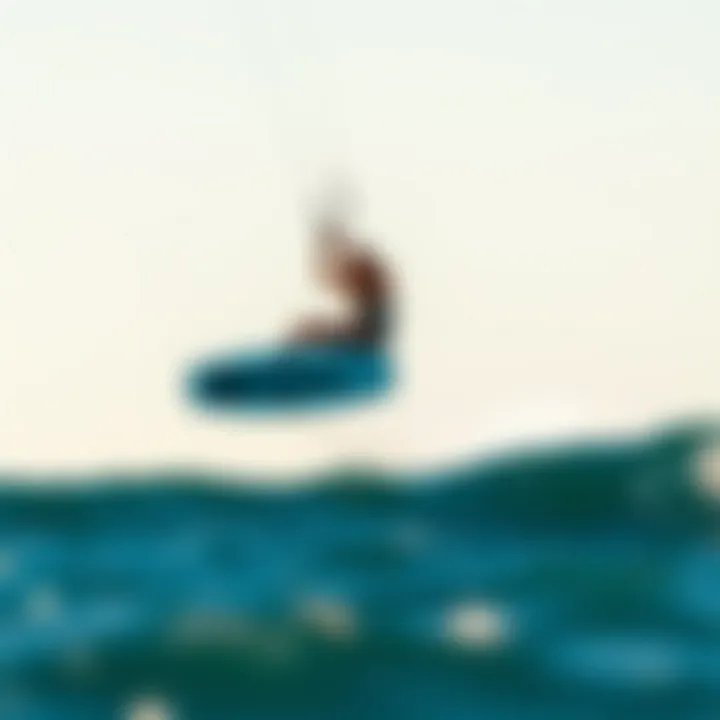
"A good kite, board, and harness make the difference between riding the waves and getting tossed around like a rag doll."
Safety Protocols in Kite Surfing
When it comes to kite surfing, safety isn’t just a priority; it’s a fundamental pillar. This sport, as thrilling as it may be, involves various risks, including the influence of unpredictable weather, equipment failures, and the natural challenges posed by water conditions. By adhering to established safety protocols, kite surfers can mitigate these risks, enhance their experience, and ensure the well-being of themselves and those around them.
Understanding Weather Conditions
Weather plays an undeniable role in kite surfing. The right wind conditions can make or break an outing, so it’s imperative to have a deep understanding of local meteorological phenomena.
Key considerations include:
- Wind Direction and Speed: Always check forecasts for both sustained wind speeds and gusts. Ideal conditions typically range from 10 to 25 knots for beginners, but personal skill levels vary.
- Tides: Understanding tidal patterns is crucial. Low tides can expose hazards like rocks or reefs, while high tides can bring stronger currents.
- Storms and Lightning: Pay attention to any signs of impending storms. Even a light drizzle should raise caution flags. Winds can shift dramatically, and lightning poses a severe threat to water activities.
Before hitting the waves, always consult reliable weather sources such as NOAA or local surf forecasts and avoid impulsive decisions based on limited information.
"Knowing when to stay ashore can be as defining as mastering your first ride."
Personal Safety Gear: Essential Items
Personal safety gear is critical in kite surfing. While many see it as inconvenient, it’s really a safeguard against unforeseen mishaps. Make sure you invest in the right equipment:
- Helmet: Protects against potential collisions with the water or each other—better to feel silly wearing one than dealing with repercussions down the line.
- Impact Vest: While a life vest is good, an impact vest can offer additional cushioning against hard landings without restricting movement.
- Harness: Choose a comfortable harness that suits your riding style—this can greatly enhance control and minimize injury.
- Safety Leash: Always attach the safety leash between the kite and the harness, ensuring that you can detach in emergencies. It’s a small detail that can save your life.
Emergency Protocols: What to Do
In the unpredictable world of kite surfing, knowing what to do in emergencies is crucial. Having protocols in place provides not just security but also peace of mind:
- Signal for Help: If you’re in distress and unable to reach shore, use visible gestures like raising your arms or waving your hands. Most surfers are aware of the signals, and immediate help could be just a glance away.
- Detach from the Kite: If all else fails, learn how to detach from your kite. Familiarize yourself with the safety systems on your gear; they’ll differ from one product to another. Don’t rely solely on others to do this for you.
- Stay Calm: Panic doesn’t help the situation. Focused breathing and maintaining composure gives you the clarity to navigate out of danger.
- Plan an Escape Route: When you hit the water, have a mental map of how you’ll get back. Familiarizing yourself with the coastline aids strategic decisions in emergencies.
By practicing these protocols beforehand, they’ll become second nature when faced with real challenges, ensuring safety and readiness.
Refer to these resources for detailed safety guidelines:
Emphasizing safety in every session will lead to a more rewarding and enjoyable kite surfing journey.
Learning Techniques for Beginners
Learning kite surfing can be one of the most exhilarating experiences for any water sports enthusiast. The importance of mastering basic techniques cannot be overstated; they lay the groundwork for achieving proficiency in the sport. Proper learning techniques help in fostering a safe environment, developing confidence, and enhancing enjoyment on the water. It allows beginners to become familiar with the dynamics of the sport, from equipment handling to understanding the kite's responsiveness in different conditions.
Initial Ground Training
Before even stepping foot into the water, initial ground training is crucial. This stage focuses on getting accustomed to the kite and its control mechanisms on land. Participants engage in various exercises that improve their understanding of how the kite behaves, which can be immensely beneficial later, once they enter the water.
A few key elements to consider during this phase include:
- Kite Setup: Check your equipment. Understanding how to properly set up your kite ensures it will perform well when it counts. Make sure the lines are untangled, each component is correctly attached, and the safety mechanisms are functional.
- Understanding Wind Window: Grasp the concept of the wind window. This is the area in which the kite can safely fly, and knowing how to position it will aid in achieving better control.
- Flying Drills: Practice basic flying techniques while on the ground. Initiate small movements, focusing on pulling and releasing the control bar. This helps in developing muscle memory, which will be crucial when navigating the water.
The hands-on experience gained through ground training provides newcomers with foundational knowledge essential for kite control and safety.
Water Launching Techniques
Once a beginner feels confident controlling the kite on land, it is time to take those skills toward the water. Water launching techniques involve several steps that ensure the safety of both the rider and those around them.
Some critical aspects to adhere to when launching include:
- Safety Checks: Always perform a thorough safety check before entering the water. This includes checking the wind direction, water conditions, and ensuring there are no obstacles nearby.
- Proper Positioning: Position the kite at the edge of the wind window before attempting to launch. This reduces the risk of the kite pulling wildly and provides more control as you prepare to get on your board.
- Launching Procedure: Learn the steps for setting your kite into the right position and ensuring it catches the wind correctly. A controlled launch involves a smooth pull on the control bar and managing line tension.
Following these techniques ensures a safer and smoother experience as you begin to ride the waves. Remember, patience during practice is key.
Controlling the Kite
Controlling the kite while on the water is an art that can take time to perfect but is indispensable for all kite surfers. Mastery of the kite’s movements directly translates to a better riding experience and can significantly enhance safety.
Points to focus on include:
- Steering Technique: Understand how the lines work. Pull down on one side of the control bar to steer in that direction. Avoid oversteering, as it can lead to loss of balance.
- Body Positioning: Maintain a balanced posture while steering, ensuring that your weight distribution allows for responsiveness in your movements.
- Reading the Water: Observing water conditions and adjusting kite positions accordingly. This will help you navigate through waves, currents, and potential hazards successfully.
The journey of kite surfing begins with these learning techniques. By diligently practicing initial ground training, water launching techniques, and kite control, beginners set themselves up for a fulfilling experience on the water.
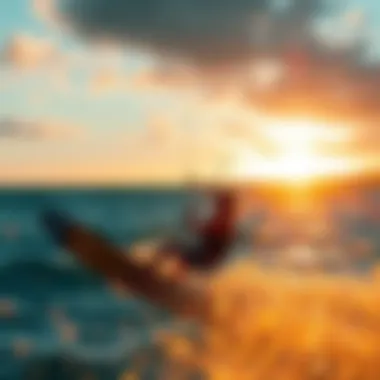
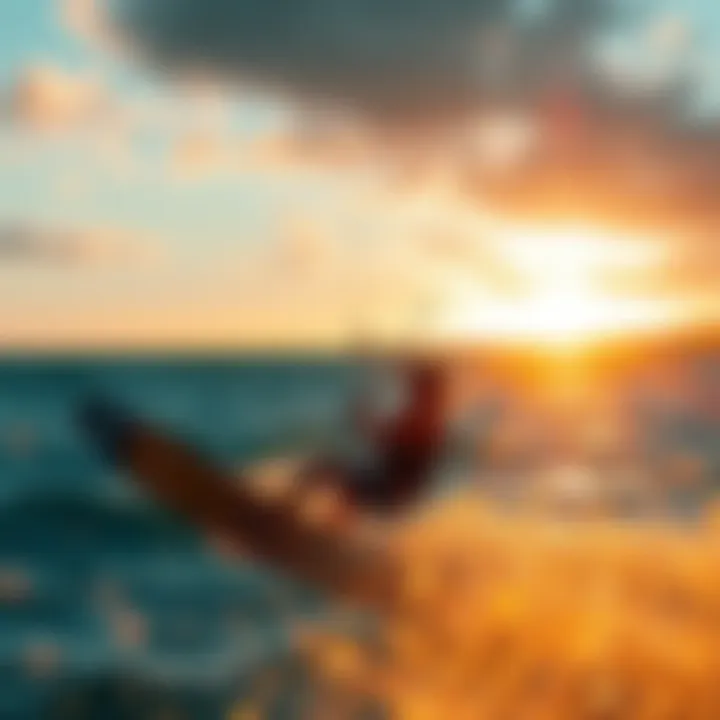
"The first step of learning kite surfing is not about the thrill of riding, but mastering the fundamentals that lead to greater enjoyment and safety in the sport."
For more information and resources on kite surfing, you can visit:
Progressing Your Skills
In kite surfing, one of the pivotal steps in mastering the sport is to continually progress your skills. This journey is not just about gliding over the water but also about refining techniques and enhancing your confidence. Every rider, from beginners to seasoned experts, stands to benefit from practicing more advanced maneuvers and understanding the subtleties of the sport. Progressing your skills will allow you to navigate challenges that come with kiteboarding, making your time on the water more enjoyable and rewarding.
Riding Techniques: Transitioning and Turns
Transitioning and turns are essential maneuvers that can elevate your kite surfing experience. These skills are not just about changing direction; they signify fluidity and control over your kite and board. When you master these techniques, you will notice an increase in speed and agility, allowing you to perform better in various wind conditions.
To execute a proper transition:
- Shift your weight: Move your body weight from your back foot to your front foot. This helps the board pivot more effectively.
- Position the kite: Bring your kite from one side to the other steadily. Keep your movements smooth to maintain your speed and balance.
- Face the new direction: As the kite swings across the wind window, turn your body to face the new direction. This can take some practice, but the ability to pivot smoothly between directions truly enhances your performance on the water.
While transitions are crucial for switching directions, learning how to turn sharply can also improve your control. Practice turns by eliminating any jerky movements. Fluidity in your turns is key to maintaining speed without losing momentum.
Jumping and Tricks: Prelims
Jumping and tricks signify a higher level of kite surfing skills. Not everyone jumps on their first day, and that's perfectly fine. However, as you build your confidence and consider enhancing your kiteboarding repertoire, understanding the basics of jumping will be beneficial.
To get started:
- Take off: Aim for a small wave or chop in the water surface. As you approach, compress your knees slightly to prepare for the jump.
- Kite position: Pull the kite sharply upward to gain lift while extending your legs. This action must be coordinated.
- Landing: As you descend, aim to soften your landing by bending your knees. Try keeping the kite at a level position to maintain control.
Keep in mind that mastering jumps requires time. Start small and gradually work your way up to more complex tricks. The sense of achievement that comes from landing even a simple jump can be exhilarating, fuelling your desire to learn even more.
Building Confidence on Water
Confidence is crucial in kite surfing. It is often the differentiating factor between a hesitant rider and a skilled kiteboarder. Building confidence doesn’t happen overnight; it’s a process that involves practice and the right mindset.
Here are some tips to foster your confidence:
- Practice regularly: Frequent practice helps in reducing anxieties. The more time you spend on the water, the better you'll get at anticipating challenges.
- Set small goals: Focus on achievable targets. For instance, mastering a basic jump before attempting to flip can keep you motivated.
- Learn from mistakes: Don’t let failures discourage you. Each tumble or rough landing provides an opportunity to learn something new about your technique or understanding of kite dynamics.
Most importantly, surround yourself with encouraging peers. Engaging with other riders will promote an enriching environment for learning and sharing experiences, helping you build both skills and confidence.
Progressing in kite surfing is a blend of skill acquisition and mental fortitude, where small improvements lead to significant leaps in your overall experience.
As you delve deeper into riding techniques, jumping, and building confidence, you’ll find yourself embracing more and more of what kite surfing has to offer, paving the way for a fascinating journey in this exhilarating sport.
Exploring Kite Surfing Locations
Exploring locations suitable for kite surfing is fundamental to the overall kiteboarding experience. The right spot not only affects performance but also influences safety, enjoyment, and personal growth in the sport. The thrill of kite surfing can be heightened when you glide across expansive blue waters, warm breezes tugging at your kite. Understanding the nuances of various locations is an instrumental step in maximizing your sessions, whether that's basking in direct sunlight on a sunny beach, or catching waves at a secluded lagoon.
Popular Kite Surfing Destinations
When considering kite surfing, several locations are hailed as favorites by the community. Each destination has its unique charm and characteristics that cater to different skill levels.
Tarifa, Spain: Known as the kite surfing capital of Europe, Tarifa's consistent winds and diverse water conditions attract riders from around the globe. Here, one can find both flat water and waves, making it suitable for beginners and veterans alike. Most instructors are skilled, offering lessons for every level.
Maui, Hawaii: A paradise for many water sports enthusiasts, Maui offers breathtaking coastlines and steady winds. Spots like Ho'okipa Beach are quite popular, where riders can experience waves and some spectacular surfing. Be ready for the vibrant kite surfing culture that flourishes here.
Cabo Verde: These islands are often called the hidden gem for kite surfers. With warm wind and flat waters, places like Sal Island provide an ideal learning environment while also offering conditions for trick progression. Don't overlook the stunning scenery as you fly above the water.
Some other noteworthy mentions include:
- Fuerteventura, Canary Islands
- La Ventana, Mexico
- Bonaire, Caribbean
The thrill of kite surfing is never far away when you are at one of these vibrant spots; choose one that speaks to you and dive into the captivating world of kiteboarding.
Local Spots and Hidden Gems
While well-known destinations are exciting, sometimes the best kite surfing experiences are found in less traveled locales. Local spots often have their own kind of magic, and they usually come with fewer crowds and a more community-oriented feel.
Lake Garda, Italy: Not just a lake, but a kite surfer’s paradise! It offers steady winds with scenic backgrounds. Riders appreciate the ease of launching from the many beaches along the coast. It’s an ideal location for both kite surfing and enjoying the stunning Italian landscape.
Hood River, Oregon: Nestled between the mountains, Hood River is famous for its strong winds and diverse conditions. It has excellent spots for all levels, and the local vibe is welcoming. It often hosts events and competitions that pull in not only riders but supporters as well.
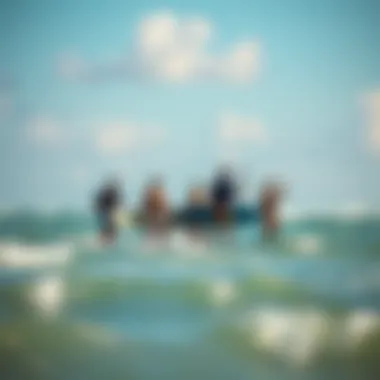
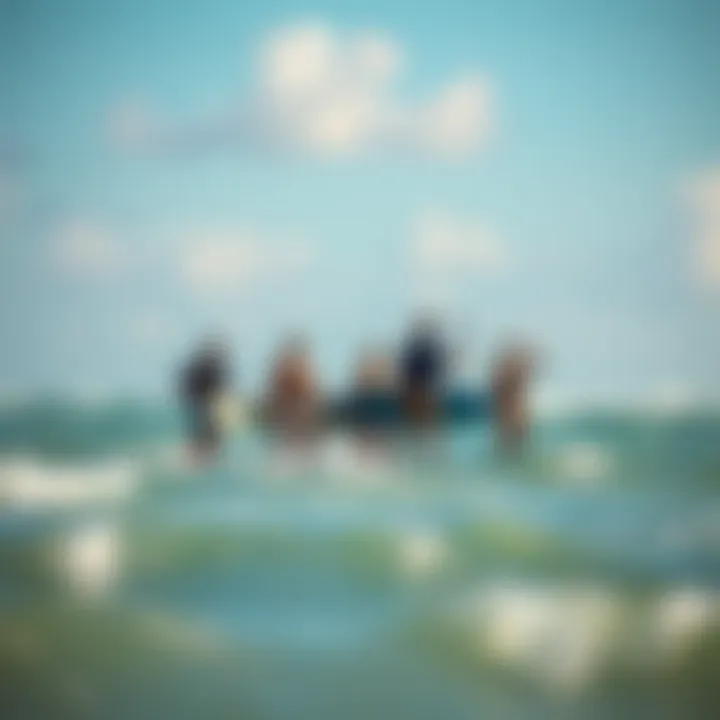
Kitesurfing Spot on the Outer Banks, North Carolina: It’s not just about surfing there; it’s a haven for kite enthusiasts. The shallow waters, paired with a reliable breeze make it an excellent location for both learning and advancing techniques.
Exploring these local spots not only allows for a unique riding experience but also offers opportunities to connect with the local kite surfing community. With any hidden gem, always be respectful of the local environment and culture.
Above all, whether riding on the bustling shores of Maui or a tranquil lake in Italy, the adventure in kite surfing starts with where you choose to kite.
The Importance of Community in Kite Surfing
Kite surfing is not just an individual pursuit; it's a collective experience that brings together enthusiasts, instructors, event organizers, and even spectators. The community surrounding kite surfing plays a crucial role in shaping the sport and enhancing the overall experience. From learning the ropes to navigating the waves, being part of a community fosters camaraderie and growth. Here are some elements that highlight the significance of community in kite surfing:
- Shared Knowledge: Learning how to kite surf comes with a steep learning curve. Experienced riders often share tips, techniques, and safety protocols that help novices to improve faster. Whether through informal conversations on the beach or organized lessons, the exchange of knowledge is vital.
- Support System: Falling in love with kite surfing can be a rollercoaster of experiences, from triumph to setbacks. A supportive community ensures that riders feel encouraged, whether they're nailing their first jump or struggling to stay upright on the board. A simple word of encouragement can often make all the difference.
As such, the community cultivates connections that can result in lifetime friendships, which adds a layer of joy to the sport beyond just riding.
Connecting with Other Riders
Making connections with fellow kite surfers can enrich your journey tremendously. Engaging with others who share the same passion allows you to learn quicker and enjoy the sport more. Sure, you can tackle waves solo, but riding with friends amplifies the experience. Here are some ways to effectively connect with other riders:
- Join Local Clubs and Schools: Many areas have kite surfing schools or clubs. Involvement not only enhances learning but provides a chance to meet enthusiasts of different skill levels. Group lessons might be more enjoyable and less daunting than one-on-one sessions.
- Utilize Social Media: Platforms like Facebook or Instagram often feature kite surfing groups where members share experiences, tips, and even organize meet-ups. Engaging in these discussions not only keeps you informed but allows for networking.
"It's not just about catching the wind; it's about catching a wave of camaraderie."
- Participate in Local Meetups: Sometimes, simply showing up at a kite surfing spot regularly can lead to spontaneous connections. Riders often congregate and share stories and tips, creating a welcoming environment for newcomers.
Events and Competitions
Events and competitions are the lifeblood of the kite surfing community, bringing everyone together in celebration of shared skills and passion. These gatherings serve a multitude of purposes:
- Showcasing Talent: Competitions allow riders to showcase their skills and learn from others. It’s where the best get a chance to shine while also inspiring budding talents in the crowd.
- Networking Opportunities: Events often draw vendors, sponsors, and industry professionals, creating a breeding ground for opportunities. Whether it’s a local beach event or an international competition, those in attendance can build connections that might lead to sponsorship or collaboration.
- Building Community Spirit: Participating in events cultivates a sense of belonging. Riders from different backgrounds come together, united by their love for the sport. Whether cheering for friends or commiserating over a fall, this shared experience forges stronger ties.
- Promoting Safety and Best Practices: Many competitions include workshops or seminars focused on safety practices, equipment maintenance, and environmental responsibility. It’s an excellent chance for newer surfers to learn from seasoned professionals.
In summary, the arts of kite surfing extend far beyond mere technique and thrill. The community nurtures relationships, fosters skill development, and promotes safety awareness. It’s an integral aspect that makes the sport as rewarding onshore as it is on the water.
Environmental Considerations in Kite Surfing
Kite surfing is more than just a thrilling sport; it offers a connection to nature that many enthusiasts cherish. However, while we embrace the excitement of gliding across the waves, awareness of environmental considerations becomes crucial. Respecting the environment helps in preserving the very landscapes where we kite surf and ensures that the beauty of these locales remains for future generations. Let's delve into two key aspects of environmental awareness in kite surfing: responsible practices on water and efforts to preserve natural habitats.
Responsible Practices on Water
When kite surfing, it’s essential to adopt responsible practices that protect both the environment and your fellow enthusiasts. Here are some important guidelines to follow:
- Avoid disturbed areas: Steer clear of marine reserves and wildlife habitats. Disturbance can disrupt delicate ecosystems.
- Be aware of your impact: Kite surf in areas where your activities won't affect local wildlife. Stick to designated kite surfing zones whenever possible.
- Respect local regulations: Before heading out, familiarize yourself with local laws regarding kite surfing zones and restrictions. Websites like noaa.gov can provide that helpful information.
- Minimal littering: Always pack out what you pack in. This includes wrappers, drink containers, and any other waste.
- Share the space: Kite surfers aren’t the only ones enjoying the water. Be courteous to other water users, such as swimmers and sailors, to ensure everyone has a good time.
"Respect for the ocean is respecting ourselves; without it, we lose everything that makes the sport worthwhile."
Promoting environmental stewardship while kite surfing not only protects the sport but also inspires others to practice responsibly.
Preserving Natural Habitats
Kite surfing inevitably interacts with the natural world, and the impact must be managed carefully. Preservation of natural habitats is vital for maintaining the delicate balance of ecosystems. Here are some measures that kite surfers can take to contribute positively:
- Engagement in conservation initiatives: Participate or support local beach clean-up and habitat restoration projects. Engaging in these initiatives helps reinforce community ties and promote sustainability.
- Learn about local flora and fauna: Understanding the natural environment in which you surf can create a greater appreciation for the ecosystem. This knowledge will help you to be more mindful during your activities.
- Advocate for sustainable practices: Share awareness about the negative impacts that come from neglecting the environment. This can be achieved through conversations with fellow surfers or engaging on platforms like reddit.com where kite surf enthusiasts gather.
- Use eco-friendly gear: Opt for equipment produced by companies that prioritize sustainability in their manufacturing processes. Teaching others about these gear choices can encourage better practices in the broader community.
Embracing environmental considerations in kite surfing can develop a conscientious culture amongst this fiercely passionate community. Each of us has a part to play in making sure that as we ride the waves, we do so with a mindful approach to the world around us.
Closure: Embracing the Kite Surfing Journey
Kite surfing is not just a sport; it’s a pathway to experiencing the wild freedom of the ocean and the thrill of harnessing the wind. This journey, layered with challenges and victories, culminates in a deeper appreciation of both oneself and the natural world. The act of kite surfing allows individuals to explore their limits, master new techniques, and discover hidden capabilities that often remain dormant. Each time you glide over the waves, it serves as a reminder of the hours spent learning, the embarrassing falls, and the small triumphs that lead to bigger accomplishments.
The importance of this journey lies not only in improving technical skills but also in building resilience and confidence. Learning to kite surf is much like learning life lessons—there will be setbacks, but the key is to get back up, adjust your approach, and keep going. Those who embrace the learning process often find themselves deeply connected to the kiteboarding community, forming bonds with fellow riders who share similar experiences.
"Kite surfing is a dance with nature, and every ride is a unique story waiting to be told."
Not to mention, kite surfing opens up the door to environmental awareness. As you engage more with the ocean, you'll begin to appreciate its delicate ecosystems—reminding you that we are custodians of the natural world. Thus, fostering an attitude of respect can strengthen your relationship with both sailing and the planet.
Reflections on Learning to Kite Surf
Every kite surfer has their own tale of discovery that reflects personal growth. Consider the moment when you first get off the water on the board, that initial feeling of weightlessness where the rules of gravity seem to bend. These moments are crucial; they fuel your passion and serve as key motivators to improve further. It’s about refining those skills over time, one carves out experiences that will define their journey, both on and off the water. Each session can unveil aspects of your personality that surprise you, revealing patience, determination, and creativity in dealing with the natural elements.
Reflecting on the myriad of lessons learned, whether from trial and error or joyous successes, can illuminate your progression. Maybe your initial attempts ended with you tangled in the lines or washed ashore, but those experiences are stepping stones. Each slip and rise contributes to a profound sense of accomplishment every kiteboarder knows well.
Encouragement for Continuous Improvement
Continuous improvement is vital in kite surfing—just as important as the thrill of mastering your first jump. Approach every outing with the mindset of a student and you will find that there’s always something new to discover. For instance, consider different wind conditions or experimenting with diverse kites and boards. Every variation presents a fresh challenge, which can enhance your skills and sharpen your instincts.
Here are practical ways to keep moving forward:
- Set Short-term Goals: Just like planning a route while navigating, set achievable goals for each session. Whether it’s perfecting a turn or nailing a trick, these targets drive continuous engagement.
- Seek Feedback: Connect with experienced riders for tips and critiques. Sometimes a different pair of eyes can catch what you missed.
- Stay Updated: The kiteboarding world evolves; keep abreast of new techniques or equipment through forums (such as reddit.com) or local clubs. Knowledge is power and can greatly influence your learning curve.
So as you wrap up your kite surfing session, perhaps look back fondly at your growth and how far you’ve come. Embracing this journey not only enhances your technical proficiency but also enriches your life experience. As with all great endeavors, kite surfing demands dedication. But those who persist will find themselves rewarded tenfold.















